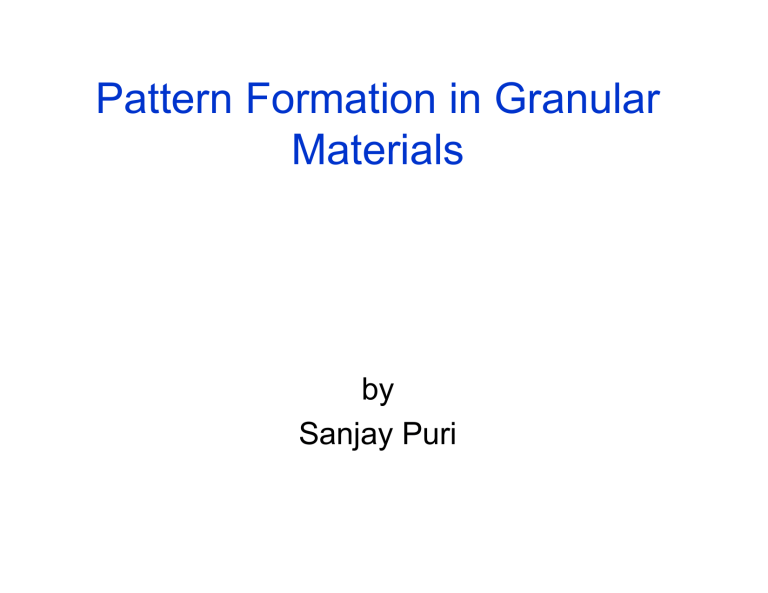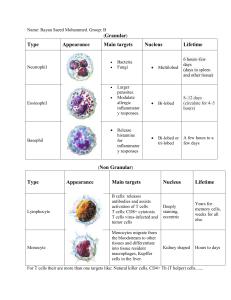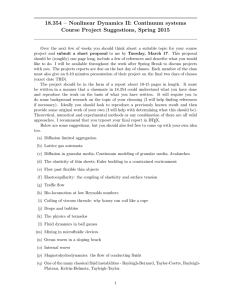
Pattern Formation in Granular Materials by Sanjay Puri Overview (a) Introduction (b) Granular Gases: Homogeneous Cooling State (c) Granular Gases: Inhomogeneous Cooling State (d) Velocity Distributions and Long-Time Tails in HCS and ICS (e) Cooling in Viscoelastic Granular Gases (f) Conclusion (a) Introduction • • • 1) 2) 3) Granular materials or powders (e.g., sand, glass) are macroscopic assemblies of inelastic particles. Typical size 10μ m – 1 cm. Particles dissipate energy on collision. Scale of assembly >> Particle size Various properties depend upon shape and size of particles, so less universality at macro-level. H.M. Jaeger, S.R. Nagel and R.P. Behringer, Rev. Mod. Phys. 68, 1259 (1996). Powders and Grains conference proceedings. N.V. Brilliantov and T. Poschel, Kinetic Theory of Granular Gases, OUP, Oxford (2004). Dynamical problems for granular materials • • Continuously input energy to compensate energy loss due to inelastic collisions, e.g., rotation in a drum vertical or horizontal vibration flow and pouring, etc. Free evolution of an initially homogeneous granular gas. 1) P.K. Haff, J. Fluid. Mech. 134, 401 (1983). 2) I. Goldhirsch and G. Zanetti, Phys. Rev. Lett. 70, 1619 (1993). Granular material in a rotating drum Laminar layer Solid bulk S-shaped surface profile is obtained by balancing the flow In the laminar layer and addition from/depletion to the bulk. P02 ω 2 2 2 θ θ μ 1 + tan tan − = R −x ( ) 2 2 3ηρ g 2 ( ) ( S. Puri and H. Hayakawa (2001) ) η viscosity ρ density μ Coulombic friction One-component granular material Glass Balls Sea Sand Ground Sand Two-component granular mixture Three-component granular mixture (b) Granular Gases: Homogeneous Cooling State Granular collisions (1 + e) ⎡ ni vi − v j ⎤ n ⎦ 2 ⎣ (1 + e) ⎡ v′j = v j + ni vi − v j ⎤ n ⎦ 2 ⎣ vi′ = vi − ( ) ( ) Restitution coefficient e=1 (elastic) e<1 (inelastic) • Density and momentum are conserved during collision. • Magnitude of normal velocity is reduced for e<1. Loss of energy (cooling) Parallelization of velocities (correlations build up) 1 − e2 ε Fraction of energy lost per collision = = d d Temperature T = and d T = − ε ω ( T ) T 2E d Collision frequency dt ω ( T ) ∝ n χ ( n )σ = ω (T 0 ) Haff’s cooling law T (t ) = Collision time τ (t ) = d d −1 T T0 T0 [1 + εω (T0 )t / 2d ]2 t ∫ d t ′ω ( t ′ ) 0 = T ε ω (T 0 ) ⎡ ln ⎢1 + ε 2d ⎣ 2d ⎛ ε ⎞ T (τ ) = T0 exp ⎜ − τ ⎟ ⎝ d ⎠ ⎤ t⎥ ⎦ Event-driven simulations in d=2,3 N=10^6, number fraction=0.2 d=2 S.R. Ahmad and S. Puri, Europhys. Lett. 75, 56 (2006); Phys. Rev. E 75, 031302 (2007). (c) Granular Gases: Inhomogeneous Cooling State • The homogeneous cooling state (HCS) is unstable to density fluctuations, due to more rapid cooling in regions of higher density. I. Goldhirsch and G. Zanetti, Phys. Rev. Lett. 70, 1619 (1993). Linear instabilities are due to Shear mode Heat mode ξ⊥ l0 ξ l0 2d ε 2d ε σ 1− d 2T l0 = = ω (T ) nχ (n) • After a crossover time, granular gas goes from HCS to ICS. Density field Velocity field e=0.9 n=0.2 • HCS to ICS crossover • Evolution morphologies in ICS: Correlation functions and structure factors of density and velocity fields. S.K. Das and S. Puri, Europhys. Lett. 61, 749 (2003); Phys. Rev. E 68, 011302 (2004). (d) Velocity Distributions and Long-Time Tails in HCS and ICS S.R. Ahmad and S. Puri, Europhys. Lett. 75, 56 (2006); Phys. Rev. E 75, 031302 (2007). For granular materials, the Maxwellian distribution in the elastic case (e=1) becomes non-Maxwellian for the inelastic case (e<1), e.g., power-law tails, exponential tails. Homogeneous Cooling State PMB ⎛ 1 ⎞ = v ⎜ 2 ⎟ π v ⎝ 0 ⎠ () d /2 ⎛ v2 exp ⎜ − 2 ⎜ v0 ⎝ ⎛ ⎞ 1 Pg v , t = ⎜ 2 ⎟ π v ( t ) ⎝ 0 ⎠ ( ) () ( F c = exp − c d /2 ⎞ ⎟ ⎟ ⎠ v0 2 = 2⟨vx 2 ⟩ = 2⟨ v y 2 ⟩ ⎛ v ⎞ F⎜ ⎟ v ( t ) ⎝ 0 ⎠ ∞ 2 ) ∑ a S (c ) 2 n=0 n n Inelastic Boltzmann equation N. Brilliantov and T. Poschel, Kinetic Theory of Granular Gases, OUP, Oxford (2004). Sonine polynomials ∞ ∫c d −1 ( ) ( ) ( )=δ dc exp −c S n c S m c 2 2 Γ ( n + d / 2) 2 nm 0 ( ) d S (c ) = − c 2 S0 c 2 = 1, 2 1 ( ) S2 c 2 a_0=1 2 a_1=0 d (d + 2) (d + 2) 2 c 4 = − c + 8 2 2 2n ! Orthogonality relation Expressions for higher Sonine coefficients are obtained from kinetic theory. 16(1− e)(1− 2e2 ) a2 = 9 + 24d + 8de − 41e + 30(1− e)e2 T.P.C. van Noije and M.H. Ernst, Granular Matter 1, 57 (1998). More accurate calculations of a_2 and a_3 are done by N.V. Brilliantov and T. Poschel, Europhys. Lett. 74, 424 (2006); S.R. Ahmad and S. Puri (2009). d=2 d=3 Inhomogeneous Cooling State We expect the velocity distribution to revert to a Maxwellian because the system is characterized by approximately independent clusters, each of which consists of parallelmoving particles. Velocity distributions in HCS e=0.95,t=11 e=0.9,t=7 e=0.8,t=4 e=0.7,t=1 Sonine coefficient a_2 vs. collision time Aging and Long-time Tails A(τ ,τ w ) ∼ 1 1 + a (τ − τ w ) d / 2 ∼ τ −d / 2 e=0.9 n=0.2 A. Mukherjee and S. Puri (2009); H. Hayakawa and M. Otsuki, Phys. Rev. E 76, 051304 (2009). (e) Cooling in Viscoelastic Granular Gases A. Dubey, A. Bodrova, N. Brilliantov and S. Puri (2010). (1 + e) ⎡ ni vi − v j ⎤ n ⎦ 2 ⎣ (1 + e) ⎡ ′ vj = vj + ni vi − v j ⎤ n ⎦ 2 ⎣ vi′ = vi − ( ) ( ) ( ) ( ) e = 1 − C1 Aκ 2 / 5 | ni vi − v j |1/ 5 +C2 A2κ 4 / 5 | ni vi − v j |2 / 5 δ = Aκ 2 / 5 Event-driven simulations in d=3 N=4.096x10^6, number fraction=0.028 Evolution of a_2 in HCS Evolution of a_3 in HCS (f) Conclusion • Freely-evolving granular gases exhibit aggregation and clustering in the density and velocity fields. This is a result of correlations induced by inelastic collisions. • Velocity distributions are non-Maxwellian in the HCS but should revert to Maxwellian in the ICS. • The velocity autocorrelation functions are characterized by aging and long-time tails. • Self-gravitating granular gases are relevant in astrophysics applications. S.R. Ahmad and S. Puri (2009). • Incorporation of poly-dispersity: mixtures with different masses, sizes, initial temperatures, inelasticity, etc. A. Mukherjee, D. Khakhar and S. Puri (2010).




